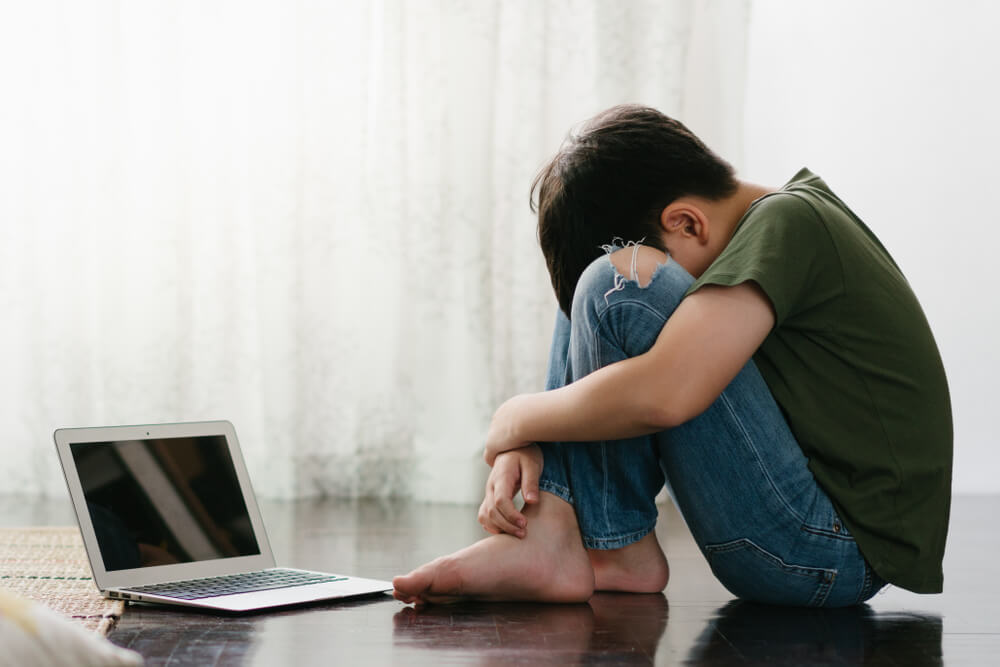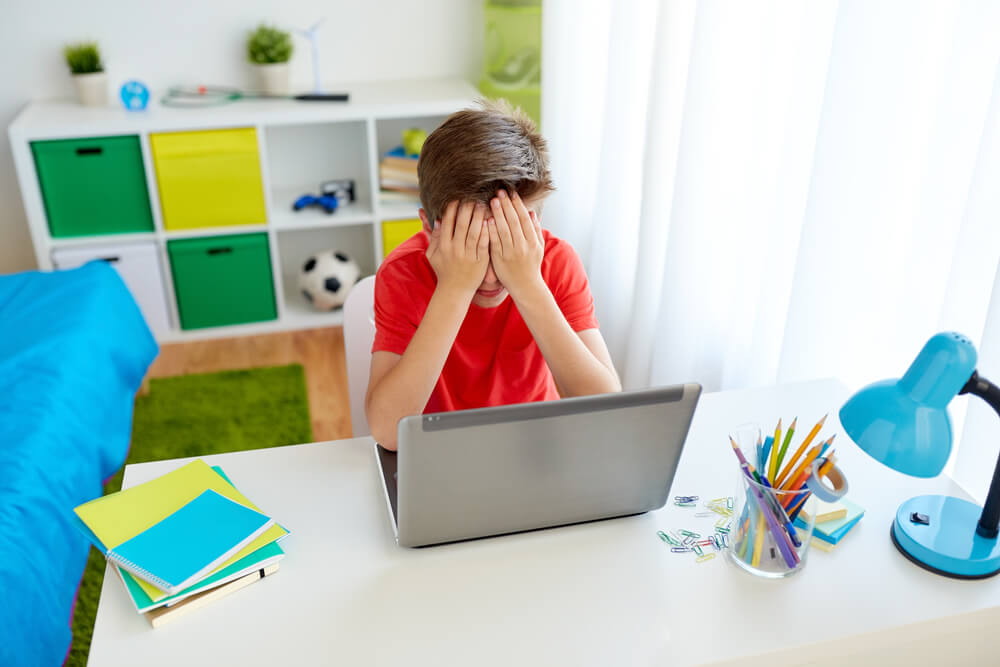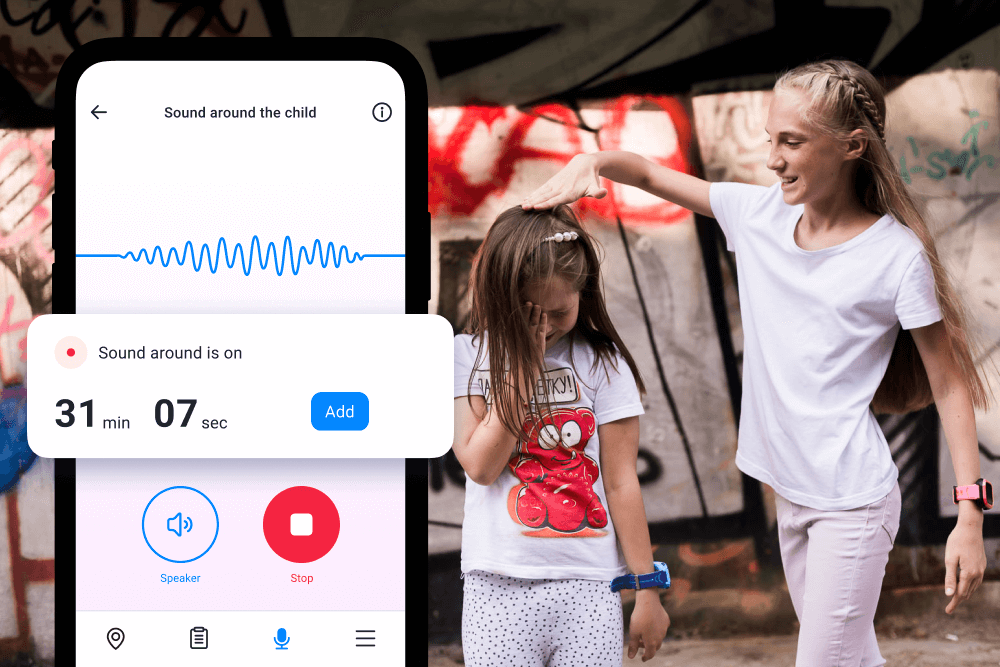Effects of Cyberbullying: Recognize, Help, Stop

The effects of cyberbullying are becoming more important to understand to keep our children safe online. As of January 2025, there are 5.56 billion Internet users worldwide. Of this number, 5.24 billion people use social media.
Social media (and other online platforms or websites) can be fun. However, there are downsides to going online.
The same people inhabit both the online and offline worlds, which means conflicts are inevitable. Traditional bullying now appears on the Internet, where some take pleasure in humiliating others.
This phenomenon is called cyberbullying, and the effects of cyberbullying on people, especially young adults, are enormous.
So how is cyberbullying different from real-world bullying? What are the effects of cyberbullying? And how can you recognize, help, and stop cyberbullying?
Keep reading to find out.
Contents:
- What is Cyberbullying?
- Why Do People Do That?
- Not Only Social Media: Places Where Cyberbullying Happens Online
- Effects of Cyberbullying on Mental Health and Social Well-Being
- Types of cyberbullying
- How to Stop Cyberbullying: Tips for Victims
- How to Smooth the Negative Effects of Cyberbullying?
- What If My Child Is an Aggressor?
- Will You Be Protected By Law?
- How to Prevent the Negative Effects of Cyberbullying?
- Useful Tool in the Сase of Cyberbullying
- FAQs
What is Cyberbullying?

Prostock-studio/Shutterstock.com
The term “cyberbullying” was introduced by psychologists in the mid-1990s to describe bullying in the online space, right at the time when the Internet hit the masses. Cyberbullying is online bullying delivered via digital means of communication (social networks, messaging apps, forums, a cell phone, etc.)
Cyberbullying can take many forms, ranging from insults and stalking to blackmail, online harassment, defamation, and theft of personal data. All forms of cyberbullying can cause psychological trauma to the victim.
Cyberbullying can take the following two forms:
- Public: In the presence of “viewers”, for example, during a discussion on social media posts.
- Personal: Insults come through private or direct messages.
It is important to note that cyberbullying is a long and systematic process. A single unflattering or angry comment cannot be considered bullying.
The cyberbullying process involves several types of people: the aggressor, the victim, and the witness.
- The Aggressor: The person who attacks the victim. By utilizing the Internet’s resources, an aggressor can hide behind multiple accounts. Some gather accomplices, which increases the amount of harm done to the victim. The concept of staying anonymous encourages attackers to take on more than they could in real life.
- The Victim: Any person can become a victim of cyberbullying (also known as cyber victimization). In fact, a large number of people have experienced this phenomenon online. According to the data, today, a staggering 1 in 3 teenagers have experienced cyberbullying, and 25% of children have faced repetitive bullying.
- The Witness: Even without being an aggressor or victim, cyberbullying can often be spotted on the Internet by a witness. Witnesses can take one of three sides by helping the aggressor, protecting the victim, or standing aside.
Who becomes the aggressor and the victim? As a rule, middle and high school students are more likely to encounter cyberbullying. Teens often lack the ability to express their feelings and emotions effectively, which can lead them to release aggression online. Nevertheless, this does not mean that any other age group of network users cannot be bullied. Compared with traditional bullying, cyber incidents can be persistent, borderless, and harder to escape.
Why Do People Do That?

Prostock-studio/Shutterstock.com
The reasons for starting to bully the victim can be completely different, for instance, resentment, envy, or anger. However, the catalyst for putting work into action is the anonymity and the permissiveness of the Internet environment.
Some of the aggressors may have been initially afraid to be among the victims, and therefore, they’ve made the decision to attack first. This often happens to witnesses of bullying. By humiliating other people and saying hurtful or demeaning things, they intend to join a stronger group or even lead it. This dynamic parallels traditional bullying, including social exclusion tactics.
Revenge is also a frequent trigger for cyberattacks. An offended friend, partner, ex-boyfriend, or girlfriend may initiate bullying to avenge their own grievances, real or imaginary. Previously close relationships with people allowed bullies to learn a lot of personal information about the victim, which worsens the situation.
Representatives of other cultures and nationalities are often the objects of ridicule. A lack of competent initiatives to bring a class together at school can lead to open conflicts on ethnic or cultural grounds.
Not Only Social Media: Places Where Cyberbullying Happens Online
Cyberbullying extends its reach into unexpected corners of the internet, often targeting victims who may not be active on traditional social media platforms. Online bullying can appear in many gaming communities, forums, and even educational platforms, making them breeding grounds for hurtful behavior. The effects of cyberbullying go beyond emotional distress; it can trigger severe outcomes like suicidal ideation and self-harm.
- Online Gaming Communities: Online gaming platforms, where young adults often spend substantial time, can unfortunately become hotspots for cyberbullying. The competitive nature of gaming sometimes leads to hurtful interactions that impact mental health.
- Educational Platforms and Forums: Even educational spaces aren’t immune. Forums and online platforms designed for learning can inadvertently host instances of cyberbullying, affecting students’ concentration and emotional well-being.
- Messaging Apps and Group Chats: Cyberbullying can transcend social media sites and seep into private messaging apps and group chats. Young people may experience hurtful comments, exclusion, or the sharing of inappropriate content.
- Dating Apps and Online Communities: In unexpected places like dating apps and online communities, cyberbullying can arise when interactions take a negative turn, causing emotional distress and damaging self-esteem.
- Video-Sharing Platforms: While video-sharing platforms foster creativity, they can also expose young adults to cyberbullying in comments sections or through negative reactions to their content.
- Work and Professional Networks: Even as young adults enter the professional world, cyberbullying may persist on work-related platforms, impacting their mental health and overall well-being.
- Content-Sharing Platforms: Platforms for sharing artwork, stories, and other creative content can turn hostile when users misuse them to target and demean others.
- Online Forums and Communities: Specialized online forums and communities on various topics can serve as venues for cyberbullying, which can impact users’ sense of belonging and confidence.
- Anonymous Question Platforms: Platforms that allow anonymous questions can enable cyberbullying by concealing the perpetrators’ identity, making it harder for victims to address the issue.
- Instant Messaging and Voice Chat Services: Even personal communication tools like instant messaging and voice chat services can foster cyberbullying, impacting young adults’ mental health and emotional well-being.
Effects of Cyberbullying on Mental Health and Social Well-Being

Prostock-studio/Shutterstock.com
Many young people are facing the distressing reality of experiencing cyberbullying, which can have severe effects on their mental health and social well-being.
The effects of cyberbullying make a long list and include:
- Anger
- Frustration
- Humiliation
- Loss of confidence
- Increase in family problems
- Feelings of worthlessness
- Violence in school
- Suicidal ideation
- Sleep disturbances
- Behavioral changes
Those who have experienced cyberbullying often carry the emotional scars, highlighting the urgent need for proactive measures to counter its harmful impacts.
While it might take an adult some time to notice changes in children, it’s essential for parents to take note. The slight changes in behavior a cyberbullied child shows are crucial to their mental health and social well-being. Such behavioral changes often include emotional withdrawal, irritability, and signs of expressive suppression—when teens hide their feelings instead of talking about them.
Other common signs include:
- Dropping grades
- Avoiding friends or social engagements
- Starting to skip school
- Hiding their device from adults and others
- Appearing angry when looking at a device
- Using alcohol or abusing drugs
- Mentioning suicide, suicide attempts, or suicidal ideation
While picking up on these changes doesn’t mean a child is being cyberbullied, it’s better to err on the side of caution.
Compared with traditional bullying at school, online bullying can follow the child home and intensify feelings of social exclusion. Over time, this emotional pressure can increase anxiety, expressive suppression, and even suicidal ideation in vulnerable teens.
А 2018 study published by Swansea University reveals that “Children and young people under 25 who are victims of cyberbullying are more than twice as likely to self-harm and enact suicidal behavior.”
With such clear and significant effects on a child’s mental health and social well-being, it’s clear that significant damage is inflicted on the victims of cyberbullying.
Negative effects are reflected not only on the victims. Witnesses are also traumatized when placed in a conflict environment. Most children are forced to take the position of aggressor in order not to become a victim. If a “defender” appears in the group, then they have to withstand colossal pressure from the aggressive majority.
Unfortunately, cyberbullying most often begins in a school environment. Therefore, parents and teachers should pay close attention to the classroom atmosphere.
Types of Cyberbullying

Prostock-studio/Shutterstock.com
Cyberbullying has become an alarming concern, with young people being particularly vulnerable to its detrimental effects. Beyond social media sites, cyberbullying pervades various online platforms, magnifying its impact. The consequences of cyberbullying can be grave, often leading to significant mental health issues such as depression, anxiety, and even suicidal thoughts. The cyberbullying victimization experienced by young adults can propel them into a distressing cycle of self-doubt and emotional turmoil.
Тrolling
It is not exactly bullying, but rather a kind of “tough challenge” and a “competition” in humor. As a rule, the troll does not care with whom and for how long to “compete”. If a more witty remark comes in response, or if the comment is completely ignored, the “humorist” will go elsewhere in pursuit of appreciation and recognition.
In 2017, Statistica revealed that 38% of 1,020 respondents see trolling daily. The negative effects of cyberbullying victimization via trolling include low self-esteem, as most people who get trolled suffer from a lack of confidence.
The best way to handle trolling is to ignore it. Most of the time, trolls want you to engage, so don’t give them the satisfaction!
Flaming
This is also not harassment yet. It is a single outburst of anger towards a person, expressed through an offensive comment or harsh criticism. As a rule, the authors of such rude messages do not require a response. They express their reaction to a specific product (such as a post, an article, a video, or a photo) and then move on, forgetting about your existence immediately.
Flaming isn’t as common as cyberbullying among young adults. According to research by the Journal of Adolescent Health, less than 5% of students report cyberbullying as an “isolated incident.” However, one of the negative effects of flaming is that when children spend more time online, they’re more likely to start using flaming themselves.
Hating
Online hating typically attacks the things a person can’t change about themselves, like race, gender, religion, disability, or sexual orientation. Statistics show that over 50% of young adults see or hear hateful comments online.
The negative effect of online hate is exhaustion, and it can lead to anxiety and depression. The best thing to do when a victim of online hate, or if you see online hate, is to report it to the online platform, website, app, or game.
Harassment

Prostock-studio/Shutterstock.com
This is bullying with clear sexual connotations. The person begins to receive messages with photographs and videos of a sexual nature, as well as inappropriate calls and messages. It can take place as a form of revenge, in which an ex-boyfriend or girlfriend begins to threaten to upload photographic or video files of an intimate nature of the victim, for everyone to see.
Research by the Pew Research Center revealed that four out of ten people in the United States experience online harassment. Half of this group stated they believe politics is why they received online harassment. The negative effect of online harassment is trauma, with symptoms related to post-traumatic stress disorder.
When being harassed online, it’s best to block, mute, and report the individual.
Defamation (dissing)
It is the dissemination of inaccurate information and rumors about the victim to causes maximum damage to their reputation. Fake chats and photoshopped images, and posts with distorted details can all be created for this purpose.
The increase in social media usage from 2005 (5%) to 2021 (75%) has greatly increased the risk of online defamation. Unfortunately, the negative effects of online defamation can completely ruin a person’s reputation to the point where they cannot find a job.
To handle online defamation, it’s best to do nothing, collect as much evidence as possible, and in some cases, hire a lawyer.
Identity theft
This type of cyberbullying occurs through hacking the user’s page or creating a copy of it and spreading negative, false information. Offensive messages may also be sent to friends, teachers (in the case of schoolchildren), etc, on behalf of the victim.
The National Council on Identity Theft Protection recently revealed that it received 1.4 million identity theft cases in 2023. One of the negative effects of identity theft is feeling overwhelmed by feelings of loss and helplessness.
The best thing to do if you are a victim of identity theft is to report the theft to the app, website, game, etc., or report it to the Federal Trade Commission (FTC).
Boycotting

Prostock-studio/Shutterstock.com
It often happens within a real group of people. The victim is excluded from public groups and chats, depriving them of the opportunity to participate in discussions and express their opinion. Any little thing that distinguishes the child from the rest of the group can become a reason for a boycott.
The negative effects of boycotting include damage to a young adult’s reputation. Instead of retaliating, it’s best to deal with this situation by being calm and sympathetic. Don’t overreact, and try to understand why people feel the way they do about you (or what you’re posting online).
Publication of personal information
This refers to any information published on the Internet about a person that is not in the public domain, which can have serious consequences for the victim. Moreover, uploading photos of an intimate nature or of a source of income on the Web without the permission of the person is a form of bullying, too.
Most people think personal data is less secure, and it’s impossible to go about their day without being tracked. And the negative effect of having personal information published is feeling a loss of control.
If personal information is shared online, report it to the appropriate sites and, if necessary, contact the local police department.
Cyberstalking
It consists of prolonged online harassment, accompanied by death threats and sexual harassment. The aggressor follows their victim literally everywhere on the web by commenting on photographs, joining the same groups, and finding out information about the victim from friends.
According to Statista, 11% of US people have experienced cyberstalking. The negative effects of cyberstalking include severe anxiety.
To address cyberstalking, gather evidence and report it to the police promptly.
Open attacks and threats of harm
These are comments and messages that contain descriptions of physical violence in a direct or indirect form, often going as far as attempting to track down the victim in the real world.
Always take threats to human life seriously because these types of threats can cause serious mental and physical harm. Report these issues to the police.
Note: Some patterns mirror traditional bullying—group pile-ons, public shaming, and social exclusion—magnified by reach and permanence online.
Cyberbullying is often not limited to one type of bullying; it is multifaceted, as it all depends on the imagination of the bully.
How to Stop Cyberbullying: Tips for Victims

Prostock-studio/Shutterstock.com
If you’ve experienced bullying, take immediate steps to preserve your own identity. The sooner you start building up your defense, the less damage you will be dealing with later.
- The first message can be ignored, or a complaint can be sent to the social or messenger support team. If it were just trolling or flaming, then ignoring would be the best way to defend yourself. Remember that you cannot be perfect for everyone, and if so, why try for the sake of someone you don’t know?
- If it seems to you that you are being bullied and humiliated systematically by one person, protect yourself from this person. Almost all messengers and social networks have the function of submitting a complaint or blocking a person.
- Even if you communicate with a person close to you, try not to transmit personal information through social networks and instant messengers to them, as they can be used against you. Remember that absolutely anyone can be on the other side of the screen.
- At the workplace, do not hesitate to report any issues to your superiors and attempt to resolve the conflict at an early stage. Do not be afraid to discuss this issue with colleagues, friends, and loved ones. The more people learn about bullying at an early stage, the less harm the future potential victims will receive.
- If you switch jobs, and aggressors appear over and over again, it may be time to revise your personality. What traits attract bullies that much? Perhaps a little self-improvement will not only help you eliminate bullying but also enable you to reach a new professional level.
If threats escalate or there is suicidal ideation, contact local emergency services and a mental health professional immediately.
How to Smooth the Negative Effects of Cyberbullying?

Prostock-studio/Shutterstock.com
All parents want their children to be healthy and happy, as well as to have friends, a good class, and the best teachers, and for their school years to be memorable and fun. However, unfortunately, this is not always the case.
Unfortunately, lots of children face bullying at school, in their peer group, or on the Internet. According to statistics, in the US, 64% of children do not tell their parents about the problems they are facing.
Signs That a Child is Being Bullied Online
- The child began to spend less time on the phone, or, conversely, started using it too often.
- The teenager appears visibly depressed, irritated, and upset after spending time on the Internet.
- The child becomes antisocial, does not want to make contact, and does not want to talk to their parents.
- The child’s academic performance is degrading.
- Their appetite is disturbed, and headaches and other psychosomatic disorders appear.
After having noticed changes in the teenager’s behavior, parents need to try to bring their child into a conversation about what is happening. No need to put pressure or spy on your child: just tell them that you are always there and ready to help them. Sometimes it is difficult for a child to admit that they have become a victim of bullying, especially if they are being blackmailed with photographs or personal information at the same time. Invite them to write you a text or record an audio message and promise not to punish or scold them for what they will confess to you.
As soon as bullying is confirmed, tell your child that this is not a normal situation and that you must work together to stop it.
Modern technology can assist you in this situation. You will either be able to check if your child is being bullied offline or online, or get evidence of bullying and use it against the bully in the future. Make sure to know which apps the child uses and how much time they spend on them, know where they are, and listen to what is happening around them with the Findmykids app.
The Plan of Defense

Prostock-studio/Shutterstock.com
- Teach your child to block unwanted visitors on their social media. Find together the functions to “complain” or “add to blacklist”, which are available on almost all Internet resources. It will work almost instantly for “occasional bullies”. If rumors, videos, or photos are spread through a community or chat where there is no way to remove the insults, contact the admin of the community or website with a request to remove the unwanted content.
- Customize the page on the social network and increase its security level. Remove all personal information that may become available to the aggressor. Prevent other users from tagging your child in photos and videos.
- Do not respond to cyberbullying and do not enter into a conversation with the abuser. The goal of the aggressor is to receive as many emotions as possible in response, thus highlighting their superiority in their mind. Ignoring their actions will push them to either make a mistake, for which they can be prosecuted, or to lose interest in the victim.
- Try to determine who is specifically bullying your child. This will allow you to punish the abuser.
- Make screenshots of conversations, comments, and other materials that will allow you to give your words some extra weight.
In the United States, 44 out of 48 states have a criminal sanction for cyberbullying or electronic harassment in place. Therefore, such actions can be considered as a basis for initiating a criminal case in the presence of threats or harassment. It is also worth noting that notarized screenshots are required to support a case. However, if bullying takes place within the school, it will be enough to show simple proof to the school’s management. - Since cyberbullying often occurs inside the classroom or school, do not hesitate to involve the class teacher, social educator, psychologist, or the school headmaster to resolve the issue. This issue needs to be addressed to help children build relationships in the classroom and to stop bullying.
Remember that a trusting and warm family relationship will allow the child to turn to you for help at an early stage and hence to receive minimal harm from cyberbullying victimization. Be patient and attentive, because it takes time for a child to heal emotionally.
What If My Child Is an Aggressor?

Prostock-studio/Shutterstock.com
Aggressors are people seeking to assert themselves at the expense of weaker people. Cyberbullies are no different. Therefore, if you notice that a child is showing aggression for no apparent reason, such as bullying other children during play or even online, use the opportunity to correct your child’s bullying behavior.
If your child exhibits mental health problems, low self-esteem, or suicidal thoughts, it’s necessary to seek the help of a psychiatrist or a mental health professional. The simple punishment of “a week without a phone” is not the right approach, and in some cases, it will only do harm.
It is necessary to ask for the support of teachers and school administration and to understand what exactly the child is trying to achieve with their behavior. It can be the willingness to attract attention, whilst being in a vulnerable position, or to take a leadership position.
Help your child understand that fear is not a sign of respect and love. Through positive reinforcement, discussion, and anger management techniques (go for a walk, scream into a pillow, etc.), show your child that an attentive, calm, and balanced leader will always be more valuable than any tyrant.
Will You Be Protected By Law?
Today, 44 states in the US recognize cyberbullying, and federal law is being proposed at the moment. Each of the 44 states provides a definition of the term “cyberbullying” from a legal perspective. Initiatives with regard to reporting bullying and anti-bullying preventative schemes, along with psychological assistance, are being provided within the communities. Moreover, some more serious offenses and cases of harassment are reported to the police or the FBI.
In order to have a foundation for your case, it is necessary to put together as many facts of misconduct as possible, such as correspondence, screenshots, etc. All this must be notarized in order to be taken into account in a hearing. It is also necessary to indicate and record the exact dates and times of the events that occurred and to provide the necessary Internet links.
How to Prevent the Negative Effects of Cyberbullying?

Prostock-studio/Shutterstock.com
Parents need to teach their children to communicate online in a safe way.
To prevent the negative effects of cyberbullying, speak to children about the following:
- Keeping personal information confidential.
- The appropriate types of photos and videos to post.
- How to prevent strangers from contacting them without consent using the app and Internet settings.
- Teach your child to say “no” and to tell an adult when they’re the victim of cyberbullying.
Children experiencing communication problems are more often chosen as targets for bullying. Therefore, try to teach your child communication skills, which will help protect your child today and in the future.
Useful Tool in the Сase of Cyberbullying
If you believe your child is at an increased risk for cyberbullying victimization, parental control apps can help.
Using a parental control app like Findmykids helps to stop cyberbullying in its tracks. It’s easy to set up and install on your child’s devices and allows you to access information about your child.
With Findmykids you can track your child’s location, listen to what’s happening around your child, and, most importantly, see mobile usage statistics.
For example, is your child on social media apps 8 hours a day? It might explain why they’re distracted. And what about their lack of enthusiasm for going to class? Have they started skipping school and avoiding friends?
Download and use Findmykids today to monitor the effects of cyberbullying and contact school administrators before this criminal behavior gets out of hand.
The Internet has given people the opportunity to communicate and speak their minds. Unfortunately, not everyone knows how to behave on the Internet.
That’s why parents and adults must teach children to communicate both in real and virtual life and remain good people even under the guise of anonymity.

The Findmykids app
FAQs
Keep reading to discover the most commonly asked questions about how to stop, help, and recognize bullying behavior.
How common is cyberbullying among teenagers and kids?
Unfortunately, cyberbullying is very common among teenagers and kids.
according to the Pew Research Centre, most teens experience bullying or harassment online. A whopping 59% of those surveyed indicated that they had been a cyberbullying target. These young adults also indicated that name-calling and rumor-spreading were the most common forms of harassment.
How can cyberbullying affect academic performance?
Studies on the effects cyberbullying victimization has on students show it can cause a wide range of mental health problems like low self-worth, anxiety, anger, and depression.
according to Psychology Today, a study conducted by the South African Journal of Information Management (SAJIM) in 2019 said that 41% of cyberbullied students became less active in class, 24% saw a drop in school performance, and 35% needed to repeat a grade.
What are some resources available for victims of cyberbullying and their families?
Adults and parents can find great resources online to help victims of cyberbullying and their families, including
- cyberbullying.org provides research support for those in need
- dosomething.org encourages youth to take action for good
- stompoutbullying.org puts an end to cyberbullying, and a chat is also available (2 days a week).
Can cyberbullying lead to physical harm?
Cyberbullying can lead to physical harm, but because this type of bullying occurs online, the type of physical harm can be different.
For example, children who experience cyberbullying can have trouble falling asleep and develop harmful eating disorders and gastrointestinal issues.
Unfortunately, there might also be occasions where cyberbullying can lead to physical harm in real life. If you, your child, or a child you know is being cyberbullied and has received threats of physical violence, contact the local police department immediately for help.
What are some effects of cyberbullying?
Emotional distress (anxiety, depression), sleep disturbances, behavioral changes, social exclusion, academic decline, and—in severe cases—suicidal ideation. Early support reduces the psychological effects and risk of traumatic events compounding over time.
How do you tell if you are being cyberbullied?
Look for patterns: repeated hostile messages, public shaming, exclusion from group chats, impersonation/cyber victimization, and fear of checking your cell phone. If it’s persistent and targeted, it goes beyond a single rude comment, then it’s cyberbullying.
How can we stop cyberbullying?
Save evidence, block/report accounts, adjust privacy settings, and involve trusted adults and school administrators. Where traditional bullying overlaps, coordinate with the school. Seek professional help if there are suicidal thoughts and prioritize safety and well-being.
Проверьте электронный ящик



















